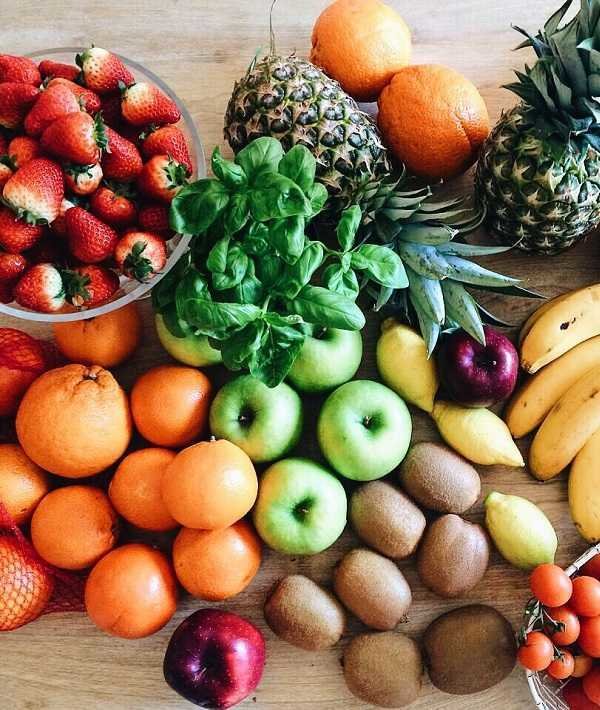
Fingernails are multipurpose tools built primarily of a protein called keratin, the same stuff found in our hair and skin. As we all know, they're great for scratching an itch and protecting our delicate fingertips from getting hurt — two jobs they evolved for. But even cooler, our nails can also provide telltale clues about the state of our health and our diets. Keep reading to find out what our nails have to say about how well we've been balancing our intake of vitamins, carbs, healthy fats, and more. It turns out that different issues with our nails can indicate to us directly what problems we have in our diet. So not only are our nails canvasses for artistic expression — perhaps, if we're being honest, our absolute favorite canvasses, which we get to walk around with all day long — but they're also great litmus tests for our overall health.
When it comes to our nail health, there are a few ways to get properly healthy nails, rather than nails that just look good but are secretly falling apart (anyone who's ever done four or five gel manis in a row knows what we mean). To get genuinely healthy, happy nails, check out this list of ways to get healthy nails, which details some natural methods to increase our nail health (and honestly, our overall health, too). One health-related nail question that seems to come up for us frequently: Is it OK to get your nails done while pregnant? Given all of the chemicals in most nail polishes — and in nail polish remover — this is a question really worth asking. But back to the "favorite canvasses for artistic expression" portion of the nail game, we'd like to invite everyone to take a peek at some of the weirdest nail art trends. Or for something to actually get on the nails, try some fabulous manicures for fall — which we adore for everyday looks around this season.
Whether the Overall Nutrition Is Good

Although everyone's fingernails can vary, there is a baseline for healthy nails. Diets rich in healthy fats, multiple nutrients, and lots of water result in nails that are typically firm and with a naturally shiny flesh-tone nail plate with a white free-edge, they're smooth (even the cuticles) and for some, have a white crescent-shaped lunula at the nail base.
Whether We're Eating Enough Fruits & Veggies

If nails are dull, weak, flaking, or simply not growing, the culprit might be a diet lacking in nutrient-rich fruits and veggies. Macro and micronutrients, like phosphorus, chloride, calcium, and more are all necessary to maintain nail shape, color, sheen, growth, and strength. When the body is low on these important nutrients, it's forced to be selective, sending the most nutrient-rich blood to vital organs first.
Whether We're Dieting Too Hard

Extreme diets, or those that severely restrict the amount of food we eat, can have a negative effect on nail health. Any diet that leads to chronic hunger or malnutrition will force the body to conserve fats and nutrients to protect its most important parts, including the heart and brain. Nails, hair, and even the skin will often get the least amount of nutrients in these situations, causing nails to become dry, brittle, and weak.
Whether We're Dehydrated

Take a look at those nails. Using gentle pressure, push on the nail plate (the base of the nail) and then examine what happens immediately after. Normal, healthy nails will turn white when pressed and then "refill" when the capillaries underneath regain their natural blood flow. Nails that take longer than half a second to refill may indicate dehydration. An easy fix? Drink more water.
Whether We're Low on Zinc

Leukonychia, or white spots on the nails, are usually caused by trauma to the nail and will naturally grow out. But the spots can also be caused by a diet low in zinc-rich foods (like shellfish). Likewise, Beau's lines (grooved, horizontal lines on the nail) can also be caused by injury, as well as diseases like uncontrolled diabetes. It could also be the body's signal that we need to slurp oysters more often!
Whether We're Low on Iron

If the nail edges curve up like a spoon, it may be koilonychia, meaning "hollow nail," a condition typically caused by severe iron deficiency. If a diet regularly includes iron-rich foods, like chocolate, spinach, lentils, and tofu, but nails still curve upwards, away from the fingertip, see a doctor. Koilonychia can also be caused by hypochromic anemia, which may include fatigue and weakness, and requires medical treatment.
If We Need More Protein

Another sign of being low on iron is the development of onychoschizia, or soft, thin nails that easily split. Since nails are made of the protein keratin, a diet that includes plenty of iron-rich proteins, like red meat, can help nails repair, grow, and maintain their strength. Quinoa, nuts, and oats are also good vegetarian options for getting iron and protein into a diet.
If We Need More Cysteine

Yet another possible explanation for brittle, weak nails may be too little cysteine in the diet. Found in beta-keratin, this important amino acid contributes to the formation of protein structures, which play a part in the growth of our nails, skin, and hair. Thankfully, foods high in cysteine are also high in protein, so eating things like soybeans, red meat, sprouted lentils, and wheatgerm can do double duty to get our nails and body in shape.
If We're Drinking Too Much

Weirdly, fingernails can reveal whether or not we're drinking too much alcohol. Not only can laboratories now test nail clippings for long-term alcohol biomarkers, but the appearance of nails can also reveal an inclination for the drink. Pale, white nails may indicate alcoholism, with a particular diagnoses called Terry's nails (where the nail appears white and has a ground-glass appearance). It often coincides with cirrhosis, diabetes, heart failure, or liver failure.
We're Getting Too Much Mercury

Sushi-lovers, beware: Apparently, there is such a thing as too much fish in the diet, especially if that fish is known to have high levels of mercury. People with brittle nails or nails that feature a single white line across the ridge (known as Mee's lines) may have heavy metal poisoning that includes arsenic, lead, or mercury. Bluefin, yellowfin, and bigeye tuna, as well as mackerel, have higher mercury concentrations — and should be eaten in moderation.
Whether We're Getting Enough Omega-3 Fatty Acids

While it's best to avoid fish with high levels of mercury, healthy omega-3 fatty acids, which are often found in fish like salmon and sardines, should be a regular part of the diet. A diet lacking in omega-3 tends to lead to nails that are brittle and weak, easily peeling or breaking. Vegetarians need not worry, either, as other foods, like walnuts, chia seeds, and Brussels sprouts are also rich in this heart-healthy fatty acid.
If We're Low on Biotin

Another cause of brittle nails, as well as dull hair and skin rashes, could be linked to a diet that's low in biotin. This important vitamin (also known as B-7) is found in egg yolks, liver, nuts, seeds, and sweet potatoes, and is often sold as a supplement to help people grow stronger, longer nails, and hair, and have more supple skin. The jury is out on whether these supplements actually help, but some studies do show that a diet high in biotin-rich foods may help people develop stronger, harder fingernails.
If The Body Is Flooded With Glucose

Too much glucose in the bloodstream is caused by the liver trying to balance the body's insulin levels. Excess glucose, which comes from diets high in sugar and simple carbohydrates, can cause fingernails to turn yellow and could be a sign of undiagnosed diabetes, which requires medical and dietary intervention.
If We're Eating Too Many Processed Foods

Another food category that causes blood sugar to spike (which, in turn, can affect nail growth) are those on the high end of the glycemic index. From white breads to flour tortillas and pizza, these highly refined, quickly digested carbohydrates create a surge in our blood glucose levels, which, over time can turn nails an unhealthy yellowish color and slow their natural growth, thanks to our bodies pumping androgen hormones in response to all the insulin.
Whether We're Eating Enough Healthy Fats

Fat has an unearned reputation for being bad for our diets. The fact is, our entire body relies on healthy fats to nourish and regenerate our cells as well as lubricate our joints. Dry, dull, and brittle nails that don't seem to grow could be a sign we're not getting enough of those good fats on a regular basis. An easy way to incorporate nourishing and heart-healthy fats into our diet is by including things like avocados, eggs, olive oil, and cheese into everyday meals.
If We're Eating Too Many Trans Fats

While healthy fats are good, trans fats — found in prepackaged cakes, pies, chips, and other snack foods — aren't. These hydrogenated oils are known to increase a person's risk of heart disease and diabetes, while also raising their bad LDL cholesterol. Although trans fats aren't directly linked to nail health, their impact on the body's overall health can lead to problems like excessive nail curving (called nail clubbing), koilonychia, which causes concave nails and Terry's nails.
If We Need To Take Dietary Supplements

If fingernails are discolored, brittle, or have vertical lines, they may be trying to say that — in addition to eating healthier foods — we need to add a multivitamin supplement to the diet. While eating a diet that is rich in heart-healthy fats, fruits, vegetables, and iron-rich proteins, we can also maximize our daily nutrient intake by adding a supplement that can help cover us when our diet doesn't include the recommended five servings of fruits and veggies per day.
If We're Low on Vitamin B-12

One vitamin in particular that is important for healthy nails is B-12. If fingernails are curving downward into our fingertips or are turning dark, it could be a sign of being low on this vitamin. An easy way to increase B-12 is by eating fortified breakfast cereals. While processed carbohydrates and sugary cereals can also damage nail health, making the advice seem conflicting, nutritionists recommend looking for cereals with whole grain as the first ingredient as well as those that are high in fiber but low in sugar.



